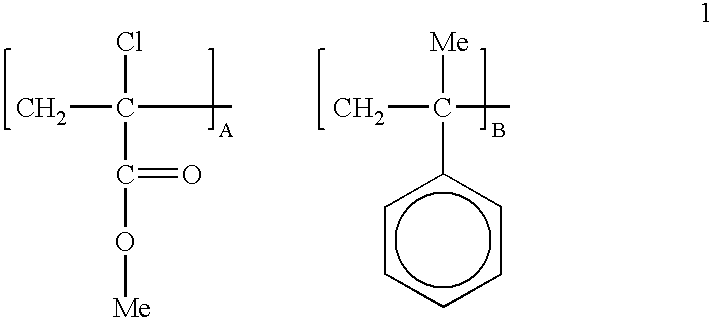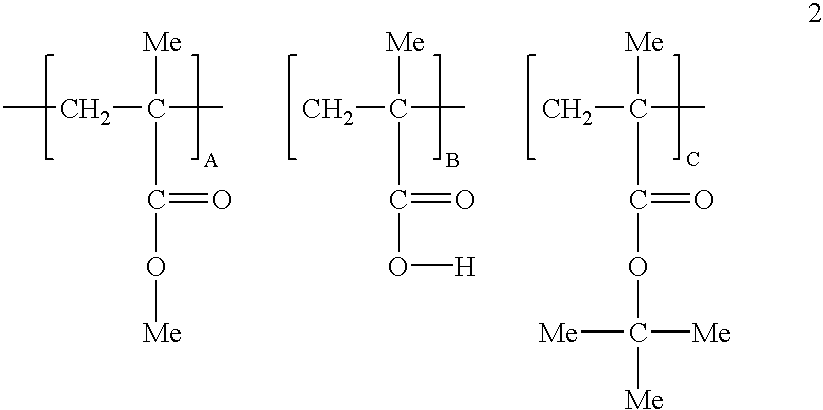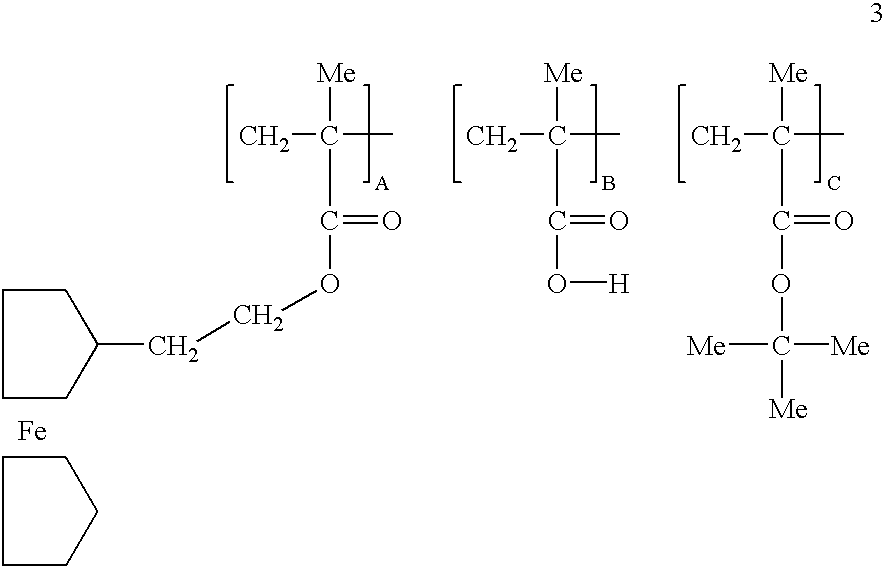Organometallic polymers and use thereof
a technology of organic polymers and polymers, applied in the field of organometallic polymers and microelectronic devices, can solve the problems of undesirable wet etching processes, conventional chemical wet processes that do not provide the resolution considered necessary, and the difficulty of achieving well-defined edges on the etched surfaces, etc., to achieve enhanced resistance to reactive ion etching
- Summary
- Abstract
- Description
- Claims
- Application Information
AI Technical Summary
Problems solved by technology
Method used
Image
Examples
example 1
Preparation of 2-Ferrocenylethyl Alcohol
2-ferrocenylethyl alcohol was synthesized by reducing ferrocenyl acetic acid with lithiumaluminum hydride. 1.4 g of LiAlH.sub.4 are placed in a flask containing ether and equipped with a soxhlet apparatus. Ferrocene acetic acid (0.9 g) is extracted by this apparatus for 48 hours. After cooling, the excess reagent is decomposed with water and the solution washed thoroughly with a solution of sodium bicarbonate, dried and evaporated to dryness. The residual oil is crystallized from hexane. It has a melting point of 41.degree. C.
example 2
Preparation of Ferrocenylethyl Methacrylate
2-ferrocenylethyl alcohol obtained from Example 1 (0.8 g) is dissolved in 300 ml anhydrous ether and 0.4 g of pyridine are added. The solution of 0.5 ml methacryloyl chloride in 30 ml ether is added dropwise and the reaction is continued for four hours. The precipitate is removed by filtration and the ether solutions are combined, washed with 5% sodium bicarbonate, 5% hydrochloric acid, sodium bicarbonate again and dried. The ether is evaporated, leaving a brown viscous oil that is further purified by chromatography over silica (ether as eluent).
example 3
Preparation of Copolymer
Ferrocenylethyl methacrylate obtained from Example 2 was copolymerized with alphachloromethyl acrylate and alphamethyl styrene. For a 1 / 4:1 / 2:1 / 4 mole ratio, a mixture of 0.785 g:0.5 g:0.295 g respectively was prepared. The mixture was placed in a glass tube together with 0.06 g AIBN. The glass tube was evacuated and selated, then maintained at 75.degree. C. for 24 hours. The polymer was freed from its monomers by dissolving in THF followed by precipitation with hexane. It was found by GPC that the molecular weight of the polymer was about 1300.
PUM
| Property | Measurement | Unit |
|---|---|---|
| feature sizes | aaaaa | aaaaa |
| etch rate | aaaaa | aaaaa |
| etch rate | aaaaa | aaaaa |
Abstract
Description
Claims
Application Information
 Login to View More
Login to View More - R&D
- Intellectual Property
- Life Sciences
- Materials
- Tech Scout
- Unparalleled Data Quality
- Higher Quality Content
- 60% Fewer Hallucinations
Browse by: Latest US Patents, China's latest patents, Technical Efficacy Thesaurus, Application Domain, Technology Topic, Popular Technical Reports.
© 2025 PatSnap. All rights reserved.Legal|Privacy policy|Modern Slavery Act Transparency Statement|Sitemap|About US| Contact US: help@patsnap.com



